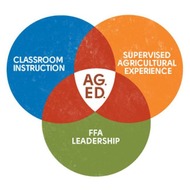Plant Structures and Functions
(View Complete Item Description)This lesson presents an overview of the importance of plants; the main parts of a plant; the types of each of the plant parts; and the relationship of each part to fruits, nuts, and vegetables. This represents a portion of the Introduction to Agriculture, Food, and Natural Resources (AFNR) series in Nebraska middle and high school agricultural education.
Material Type: Activity/Lab, Assessment, Lesson Plan




















